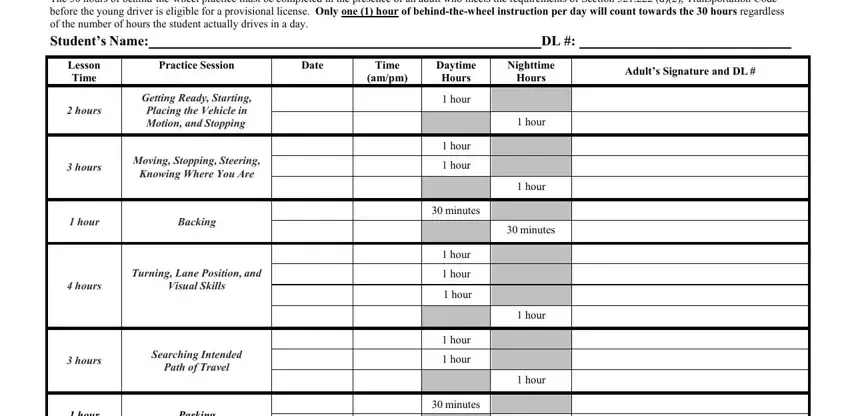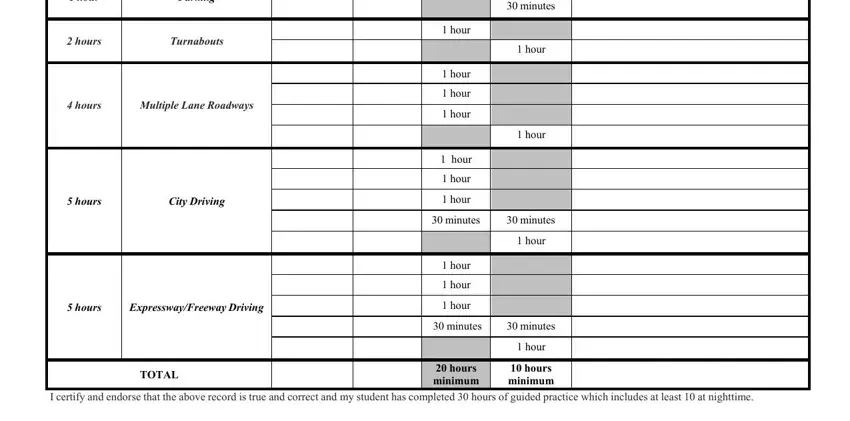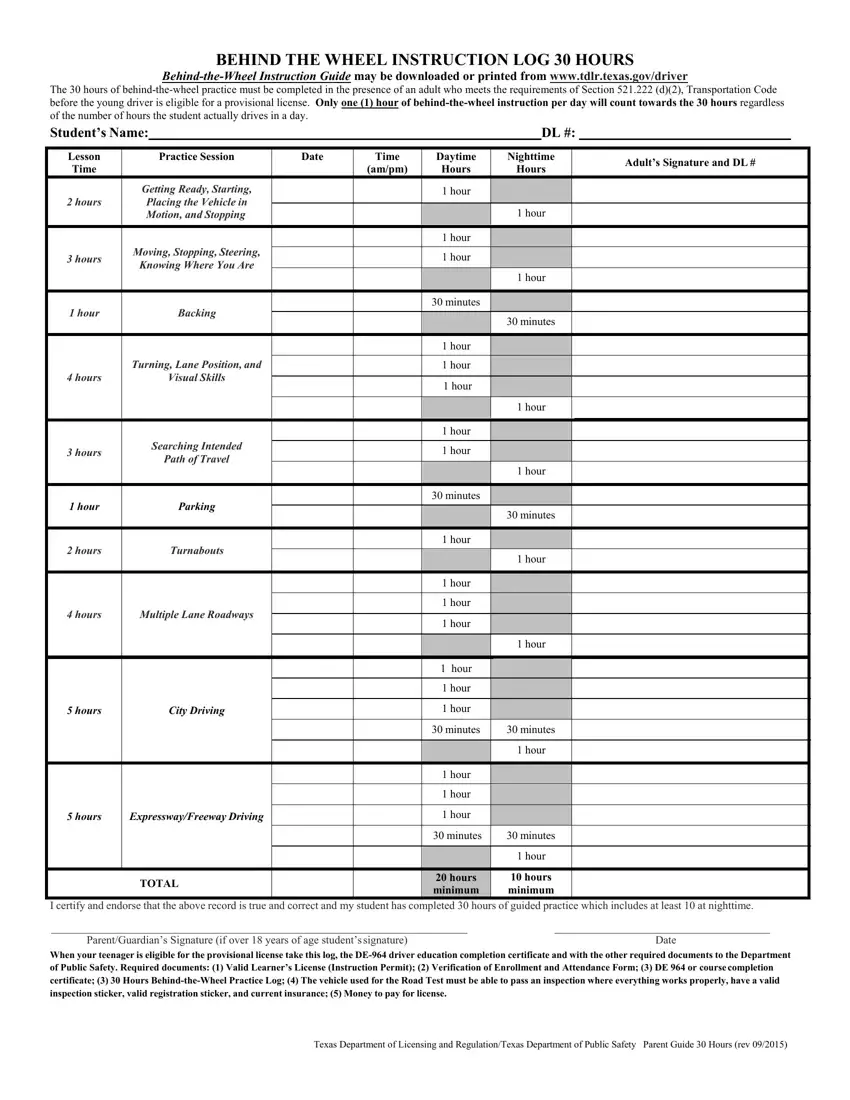BEHIND THE WHEEL INSTRUCTION LOG 30 HOURS
Behind-the-Wheel Instruction Guide may be downloaded or printed from www.tdlr.texas.gov/driver
The 30 hours of behind-the-wheel practice must be completed in the presence of an adult who meets the requirements of Section 521.222 (d)(2), Transportation Code before the young driver is eligible for a provisional license. Only one (1) hour of behind-the-wheel instruction per day will count towards the 30 hours regardless of the number of hours the student actually drives in a day.
Student’s Name: |
|
|
|
|
DL #: |
|
|
|
|
|
|
|
|
|
|
|
|
|
Lesson |
|
Practice Session |
Date |
Time |
Daytime |
Nighttime |
|
Adult’s Signature and DL # |
|
Time |
|
|
|
(am/pm) |
Hours |
Hours |
|
|
|
|
|
|
|
|
|
Getting Ready, Starting, |
|
|
1 hour |
|
|
|
|
|
2 hours |
Placing the Vehicle in |
|
|
|
|
|
|
|
|
|
Motion, and Stopping |
|
|
|
1 hour |
|
|
|
|
|
|
|
|
1 hour |
|
|
|
|
|
|
|
|
|
|
|
|
|
|
|
3 hours |
Moving, Stopping, Steering, |
|
|
1 hour |
|
|
|
|
|
Knowing Where You Are |
|
|
|
|
|
|
|
|
|
|
|
|
|
1 hour |
|
|
|
|
|
|
|
|
|
|
|
|
|
|
|
|
|
|
|
30 minutes |
|
|
|
|
|
1 hour |
|
Backing |
|
|
|
30 minutes |
|
|
|
|
|
|
|
|
|
|
|
|
|
|
|
|
|
|
|
|
|
|
|
|
|
|
|
|
1 hour |
|
|
|
|
|
|
Turning, Lane Position, and |
|
|
1 hour |
|
|
|
|
|
4 hours |
|
Visual Skills |
|
|
|
|
|
|
|
|
|
|
|
1 hour |
|
|
|
|
|
|
|
|
|
|
|
|
|
|
|
|
|
|
|
|
|
|
|
|
|
|
|
|
|
|
|
1 hour |
|
|
|
|
|
|
|
|
|
|
|
|
|
|
|
|
|
|
|
1 hour |
|
|
|
|
|
3 hours |
|
Searching Intended |
|
|
1 hour |
|
|
|
|
|
|
Path of Travel |
|
|
|
|
|
|
|
|
|
|
|
|
|
1 hour |
|
|
|
|
|
|
|
|
|
|
|
|
|
|
|
|
|
|
|
30 minutes |
|
|
|
|
|
1 hour |
|
Parking |
|
|
|
30 minutes |
|
|
|
|
|
|
|
|
|
|
|
|
|
|
|
|
|
|
|
|
|
|
|
|
|
|
|
|
1 hour |
|
|
|
|
|
2 hours |
|
Turnabouts |
|
|
|
1 hour |
|
|
|
|
|
|
|
|
|
|
|
|
|
|
|
|
|
|
|
|
|
|
|
|
|
|
|
|
1 hour |
|
|
|
|
|
|
|
|
|
|
1 hour |
|
|
|
|
|
4 hours |
Multiple Lane Roadways |
|
|
|
|
|
|
|
|
|
|
1 hour |
|
|
|
|
|
|
|
|
|
|
|
|
|
|
|
|
|
|
|
|
|
|
|
|
|
|
|
|
|
|
|
1 hour |
|
|
|
|
|
|
|
|
|
|
|
|
|
|
|
|
|
|
|
1 hour |
|
|
|
|
|
|
|
|
|
|
1 hour |
|
|
|
|
|
|
|
|
|
|
|
|
|
|
|
|
5 hours |
|
City Driving |
|
|
1 hour |
|
|
|
|
|
|
|
|
|
|
30 minutes |
30 minutes |
|
|
|
|
|
|
|
|
|
|
|
|
|
|
|
|
|
|
|
1 hour |
|
|
|
|
|
|
|
|
|
|
|
|
|
|
|
|
|
|
|
1 hour |
|
|
|
|
|
|
|
|
|
|
1 hour |
|
|
|
|
|
|
|
|
|
|
|
|
|
|
|
5 hours |
Expressway/Freeway Driving |
|
|
1 hour |
|
|
|
|
|
|
|
|
|
|
30 minutes |
30 minutes |
|
|
|
|
|
|
|
|
|
|
|
|
|
|
|
|
|
|
|
1 hour |
|
|
|
|
|
|
|
|
|
|
|
|
|
|
TOTAL |
|
|
20 hours |
10 hours |
|
|
|
|
|
|
|
|
|
|
|
|
minimum |
minimum |
|
|
|
|
|
|
|
|
|
|
|
I certify and endorse that the above record is true and correct and my student has completed 30 hours of guided practice which includes at least 10 at nighttime.
Parent/Guardian’s Signature (if over 18 years of age student’ssignature) |
Date |
When your teenager is eligible for the provisional license take this log, the DE-964 driver education completion certificate and with the other required documents to the Department of Public Safety. Required documents: (1) Valid Learner’s License (Instruction Permit); (2) Verification of Enrollment and Attendance Form; (3) DE 964 or coursecompletion certificate; (3) 30 Hours Behind-the-Wheel Practice Log; (4) The vehicle used for the Road Test must be able to pass an inspection where everything works properly, have a valid inspection sticker, valid registration sticker, and current insurance; (5) Money to pay for license.
Texas Department of Licensing and Regulation/Texas Department of Public Safety Parent Guide 30 Hours (rev 09/2015)
BEHIND THE WHEEL INSTRUCTION LOG 30 HOURS
Behind-the-Wheel Instruction Guide may be downloaded or printed from www.tdlr.texas.gov/driver
The 30 hours of behind-the-wheel practice must be completed in the presence of an adult who meets the requirements of Section 521.222 (d)(2), Transportation Code before the young driver is eligible for a provisional license. Only one (1) hour of behind-the-wheel instruction per day will count towards the 30 hours regardless of the number of hours the student actually drives in a day.
Getting Ready, Starting, Placing the Vehicle in Motion, and Stopping (p. 14) Recommended 2 hours -- These practice sessions introduce your teenager to the instrument panel, vehicle controls, and mirror blind spots. The young driver should get ready to drive, start the vehicle, place the vehicle in motion, stop, and secure the vehicle. Please review the vehicle owner’s manual before and during these practicesessions.
Moving, Stopping, Steering, Knowing Where You Are (p. 15) Recommended 3 hours -- Focus on learning the correct procedures for moving, stopping, using reference points, and steering the vehicle at different speeds. Begin in a large, level parking lot that is free of obstacles. The teenager should practice driving around the perimeter of the lot at 10 and 15 mph. Using commentary driving, have your teenager focus on smooth push-pull-slidehand-to-hand steering and stops. Your teenager should be taught to ease off the accelerator or use the brake to reduce speed before entering a curve and useslight acceleration to overcome inertia and pull the vehicle out of the curve. Ask the teenager to move the vehicle to specified targets in the parking lot at 10 and 15 mph. The target is a fixed object that is located 12-20 seconds ahead of the vehicle, in the center of the path of travel, and is what the driver steers toward. It can be a car a block ahead, a traffic signal, the crest of a hill, etc. Having a target helps the new driver to: visualize the space the vehicle will be occupying; look far ahead of the vehicle and begin a search to identify risks; improve steering accuracy. Focus on smooth acceleration, proper speed, and smooth stops. Explain to your teenager that “curling” the toes back to ease pressure off the brake just before stopping results in smoother stops. Practice normal smooth stops and hard smooth stops which are done at a slightly higher speed.
Backing (p. 16) Recommended 1 hour -- Repeat the tasks listed in sessions Moving, Stopping, Steering, Knowing Where You Are with the vehicle in reverse gear at idle or slow speeds. Backing from one target to another allows your teenager to practice seeing, steering, and speed control skills with the vehicle in reverse gear.
Turning, Lane Position, and Visual Skills (p. 16) Recommended 4 hours -- During the next practice sessions practice 10-15 right and left turns from stopped and moving positions in a parking lot. Left turns should be “squared” and right turns should be “rounded.” Emphasize proper signals, mirror checks, side- position reference points, speed and steering control, and the need to look ahead of the vehicle at a selected target in the center of the path of travel. Warn young drivers not to fixate on any one thing. Prior to progressing to driving in a quiet neighborhood, your teenager should be able to demonstrate the ability to move and stop the car smoothly, maintain a given speed, and steer with reasonable precision. If your teenager is ready, practice right and left turns in a residential area.
Searching Intended Path of Travel (p. 18) Recommended 3 hours -- In a residential area, or, if ready, on roads with light traffic, continue working on basic visual skills, negotiating curves, and right and left turns. Practice judging space in seconds, identifying a target, and searching the target area and target path. Ask your teenager to comment prior to changing speed or position. Young drivers have the tendency to monitor the road immediately in front of the vehicle.
Parking (p. 19) Recommended 1 hour -- Angle Parking, Perpendicular Parking, Parallel Parking, Curb Parking, Parking Uphill, Parking Downhill
Turnabouts (p. 21) Recommended 2 hours -- Focus on recognizing the different types of turnabouts and selecting the appropriate type of turnabout for a given situation. Begin in a large, level parking lot free of obstacles. Practice 2-point, 3-point, and U-turns in a parking lot. Progress to a lightly traveled residential area, and practice visual search skills, turns, and each turnabout at least 10 times. The easiest and safest way to change directions is to drive around the block.
Multiple Lane Roadways (p. 22) Recommended 4 hours -- Focus on lane position, lane changing, following distance, and mirror blind spots. If possible, choose a time when the four-lane roadway on which you select to practice has minimal traffic, such as during early morning hours on Saturday or Sunday. There are several lane position choices a driver can make without changing lanes. Practice driving in lane position 1, 2, and 3 for several miles during each session.
City Driving (p. 24) Recommended 5 hours -- Focus on driving on crowded urban roadways. During these practice sessions have your teenager examine the importance of scanning ahead, lane position, covering the brake, and the hazards associated with parked cars, traffic congestion, and distractions. Decision- making is the most important skill used in driving. A driver operating in city traffic flow makes 50-60 decisions per mile. Drivers need visibility, space, time, and adequate traction to perform all maneuvers in city traffic whether crossing, turning, passing, or adjusting speed and/or position. Duringthese sessions ask your teenager to focus on controlling space to the front and speed to enhance visibility, space, time, and traction. Driving on congested roadways allows a very small margin for driver error. Effective searching skills and driver alertness are both essential. Every second counts in this driving environment.
Expressway/Freeway Driving (p. 25) Recommended 5 hours -- Focus on complex risk driving environments at speeds up to 70 mph. Traffic flow on expressways can be heavy and at times unpredictable. They are called limited access highways because there are only certain locations, called interchanges, where a driver can enter and exit the expressway. Expressways have a low frequency of collisions, but often have high injury severity rates when a collision does occur because of the higher speeds. Review the expressway information in the Texas Driver Handbook. Make sure your teenager understandsthe different kinds of expressway interchanges, expressway signs, signals, lane markings, speed limits, and the importance of maintaining a 20-30 second visual lead.
Texas Department of Licensing and Regulation/Texas Department of Public Safety Parent Guide 30 Hours (rev 09/2015)




